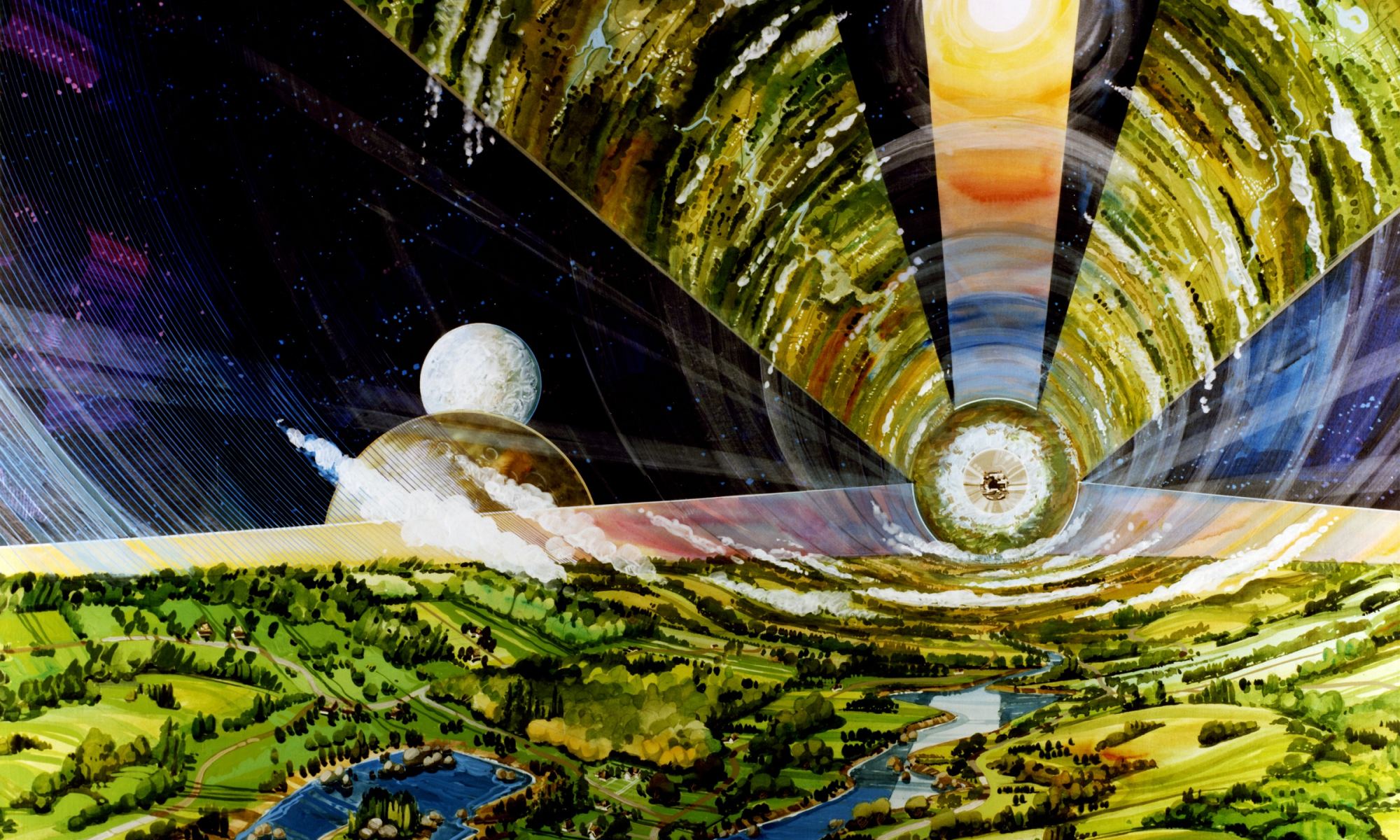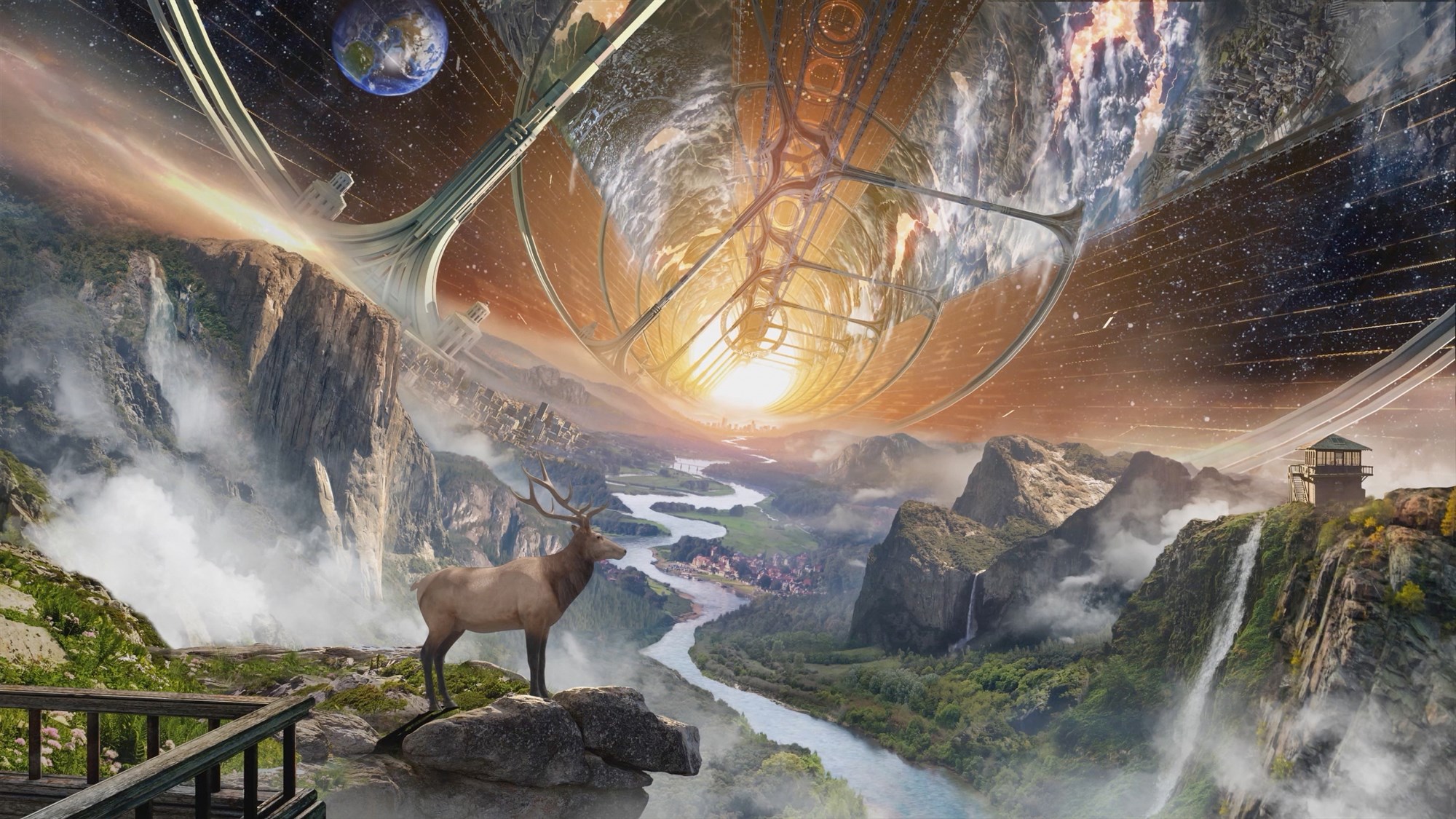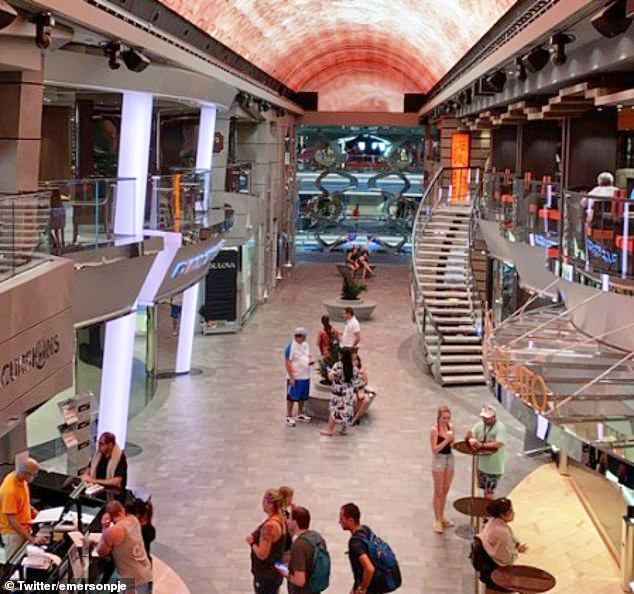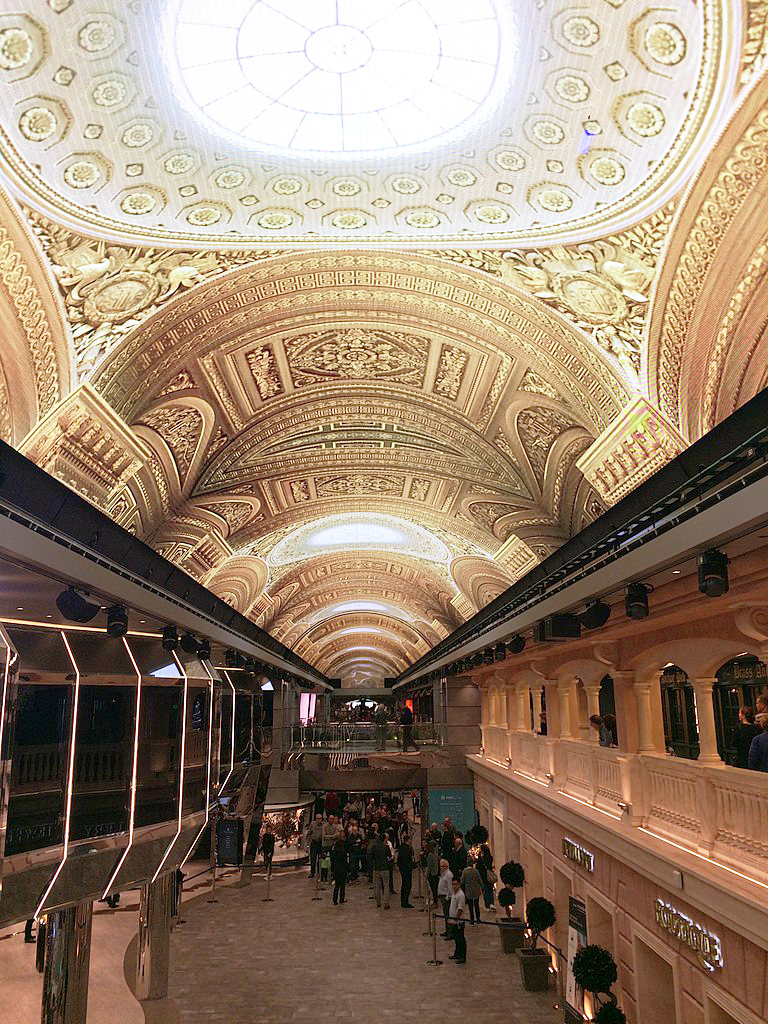= ASTRONAUTICAL EVOLUTION =
Issue 152, 1 March 2020 – 51st Apollo Anniversary Year
| Site home | Chronological index | Subject index | About AE |
Read this post on Wordpress if you wish to leave a comment
Cruising in Space
When writing about space colonies or worldships, the go-to picture always seems to be one dating from O’Neill’s studies from the 1970s, or else one closely based on those. Case in point: today’s post on generation ships in Universe Today.
The image at the head of the article (see left) shows the typical landscape of fields, lakes and rivers imitating a countryside scene in a developed country on Earth, with occasional villages and towns. (The article is unfortunately amateurishly written: it contains nothing new and repeats some well-worn and misleading clichés.)
Incidentally, I found a nice 3-D video animation, by artist Eric Bruneton, of a flythrough of one of these giant cylindrical habitats, again showing very much a late 20th to early 21st century landscape of fields and cities. It is linked to from the National Space Society website where it is described as an animation of Arthur C. Clarke’s fictional Rama – this is incorrect: it is merely “freely inspired” by the famous alien megastucture in Clarke’s novel.
For more of these images, see the collection on the Core 77 design website.
Only problem is: I doubt whether space colonies will ever actually look like this.
In 2012 I wrote:
“Since a space habitat as described by O’Neill and by Bond and Martin has a large interior volume filled with nothing but air, it offers its owners the temptation, or the opportunity, to fill at least part of that volume, working inwards from the rim, with structures in which increased numbers of inhabitants can live, work, and earn money to pay the rent.
“It may be safely anticipated that during at least the first centuries of space colonisation, the cost of a space colony relative to equivalent accommodation on Earth will be high. The economic pressure will therefore be towards efficient utilisation of its interior volume, making it look less like the idyllic pastoral village landscapes of O’Neill’s vision (illustrated in paintings by Pat Rawlings), or the Earth-like diorama envisaged by Bond and Martin, and more like central Tokyo or New York. (The rustic paradise will be provided in the form of virtual reality simulations.)”
I think one can get an insight into likely space colony interiors by looking at modern cruise liners.
The ocean cruising industry carried around 27 million passengers in 2018, with a compound annual growth rate of 6.63% over the period 1990 to 2020. A dozen new ships (listed here) are coming into service every year to serve that demand, the largest of which have berths for 4,000 to over 5,000 passengers. These ships are clearly highly desirable places to spend time, despite their being highly artificial, high-technology, high population density environments.
Cruise liners are therefore good analogues for space colonies, once allowance has been made for a few differences:
- The lack of a natural outside to a space colony, open to sunshine and to the global air circulation, and the lack of ports of call with green spaces, require the addition of interior park spaces, or what in a skyscraper would be called sky gardens;
- The presence of a microgravity space close to the axis of rotation creates new opportunities for recreational activities;
- A space colony needs to provide, in addition to residential and recreational space, working space for those of its inhabitants who are earning a living;
- A space colony requires a formal political system to govern the lives of its inhabitants;
- A space colony must bring all life-support loops to a high degree of closure, recycling its air, water, foodstuffs and manufactured products, and maintaining a healthy microbial environment. The loops need not be entirely closed, as Mark Hempsell has pointed out, if a number of space colonies are located closely enough to allow trade between them; for example, this would be the case for colonies orbiting together in cislunar space.
So what would life look like on a glorified cruise liner? Here are a couple of shots of the central arcade on the MSC Meraviglia. Note that the arched ceiling is coated in LED lights, allowing it to display many different patterns.
This particular ship was completed in 2017, and can carry up to 4,500 passengers and 1536 crew. The size is given as 171,598 gross tons; according to the modern definition of gross tons, this represents a total enclosed volume of 545,220 cubic metres. This allows us to get a feel for the amount of space allowed per passenger. Suppose that the crew are removed and replaced with robots, and suppose that the ship’s engines are also removed and replaced with recycling machinery. Assuming a ceiling height of 3 metres, the calculated volume then equates to a deck space of 40 square metres per passenger at full capacity, including utility areas devoted to their life support but not directly accessible by them.
Other modern passenger ships have similar dimensions, between 59 square metres per person on Cunard’s Queen Mary 2 and only 36 square metres per person on what is currently the largest cruise liner in the world, Royal Caribbean’s Symphony of the Seas.
If this was the whole story, the resulting population density would be quite large: 25,000 people per square kilometre, comparable with the most densely settled urban districts (such as the municipality of Le Pré-Saint-Gervais in Paris).
But such urban centres on Earth depend upon global agricultural and industrial hinterlands. In a space colony – thinking now of one located in a remote part of the Solar System, and especially if being used as a worldship for interstellar travel, or even for multi-year travel between the inner and outer Solar System – all the functions of these hinterlands – plus also the buffering functions of the global atmosphere and hydrosphere – would have to be replicated on board.
After considering the matter realistically, then, a population density somewhere in the region of 5,000 per square kilometre is probably the greatest that one would want to achieve. (O’Neill proposed 10,000 people occupying a little over one square kilometre in his original Island One design.)
On the other hand, the multi-deck nature of the space colony as I envisage it, filling up between one half and two-thirds of that empty interior space with superstructure, and creating the majority of interior vistas similar to those of cruise ships, would certainly pack a lot more people in per thousand tonnes of construction materials invested into the megastructure.
References
S. Ashworth, “The Long-Term Growth Prospects for Planetary and Space Colonies”, JBIS, vol.65 no.6 (June 2012), on p.206.
M. Hempsell, “Sky Farm: Feeding a Large Space Population”, JBIS, vol.70 no.1 (January 2017), p.3-11.
G.K. O’Neill, The High Frontier (1977; 3rd edn, Space Studies Institute, 2000).
To make comments, please visit this post on Wordpress.
| Site home | Chronological index | About AE |



